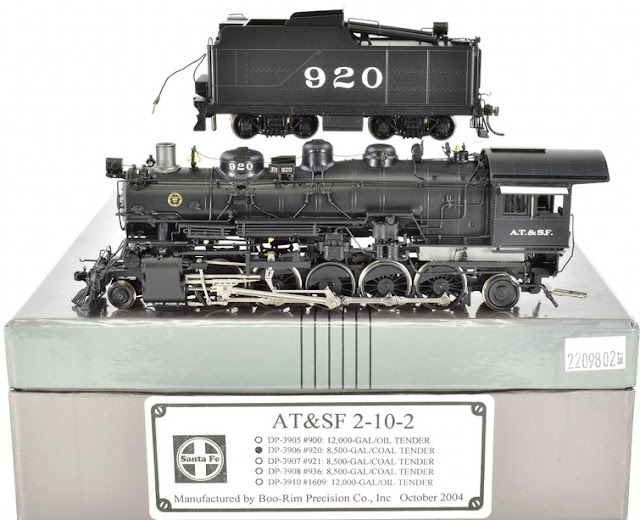This time we'll look at Santa Fe's early 2-10-2 steam locos that were operating in Victorville in the late 1940s. Then we'll look at a little more layout progress, thanks to two more helpers who visited me.
Santa Fe's first 2-10-2 steam locos were built in 1903-1904 and were numbered 900-984. A virtually identical group of 2-10-2s were built in 1905-1907 and were numbered 1600-1673. In 1912-1913 they got another batch, numbered 1674-1705.
Two more groups were created when they cut apart the unsuccessful 2-10-10-2 locos of the 3000-class into two halves in 1915-1918. These became numbers 3010-3019 and 3020-3029.
So, the early 2-10-2 locos we'll look at here are from the 900 class, 1600 class, 1674 class, 3010 class, and 3020 class.
Here we see two locos from the 900 class, #945 and #979, taking water at Keenbrook while uncoupled from the rear of an eastbound freight in June, 1949, thanks to Jack Whitmeyer:
Frank Peterson shot #979 helping bigger 2-10-2 #3833 with a westbound freight near Frost (after leaving Victorville) in 1947:
Here we see #1626 and #979 pushing on the rear of an eastbound freight at Pine Lodge in June, 1949, in a nice shot by Stan Kistler:
Herb Sullivan shot #1676 helping a 4-8-4 with an eastbound passenger train approaching Sullivan's Curve in 1946:
In May of 1950, Jack Whitmeyer shot #1677 in the San Bernardino B Yard (all the other shots I've seen of these locos were taken in 1949 or earlier):
Here's an action shot of #1677 with an eastbound freight at Cajon in June, 1949, thanks to Stan Kistler:
Stan Kistler also shot #1689, freshly shopped at San Bernardino in Feb. 1947:
James Ady shot #3013 and 4-8-2 #3723 pushing an eastbound freight at Devore in August of 1947:
Finally, Tom Baxter shot #3014 at San Bernardino in Nov. 1948:
As we've seen, these locos were normally used as helpers on Cajon Pass in the postwar years, and they were out of action after 1949 or 1950.
There have been various HO brass models of the locos in these similar classes.
Hallmark made a 900-class model, like this one (mine is #979):
Division Point also made a 900 class, but I don't have this model (and this one happens to have a coal tender):
Westside made a 1600 class, as seen here with a turtleback tender (mine is #1690):
Division Point also made a 1600-class loco, which I don't have:
Westside also made a 3010-class loco (mine is not yet painted):
Now it's time for a layout progress update. I had no visitors the week before last, due to all the snow we got that week.
But I bought some Velcro parts and found a way to make straps to support my bus wires along the edges of the layout. I bought a roll of 3/4" wide Velcro strap,
which I cut into 4" lengths, which are about right for attaching to the
benchwork and then rolling into a circle around the bus wires. I also
bought a pack of 7/8" square sticky-back Velcro squares for attaching
the straps to the inside of the 1x4" edge boards.
I also did some initial design work for the three mainline control panels, one for each of the three "tower" areas around the layout. I think I should build and wire these mainline panels before dealing with the separate yard panels:
The large circles are the rotary switches to assign cabs
to blocks, and the small vertical ovals are the toggles for the powered
switch machines (I added an X beside those that control both turnouts in
a crossover). Each switch toggle will also need a momentary pushbutton
beside it, but I didn't yet draw those in. The short lines through the
tracks are the block boundaries (a double line marks the end of a
reversing section).
My wiring advisors, Tim Fisher and Richard Mukai, reviewed this drawing and got back to me with some improvements I need to make when I find time. We're also discussing what electrical parts I need to buy for these panels.
While Ray was working for almost four hours, I was adding more masking tape to lift the bus wires and their connectors into the right locations for Ray.



















No comments:
Post a Comment